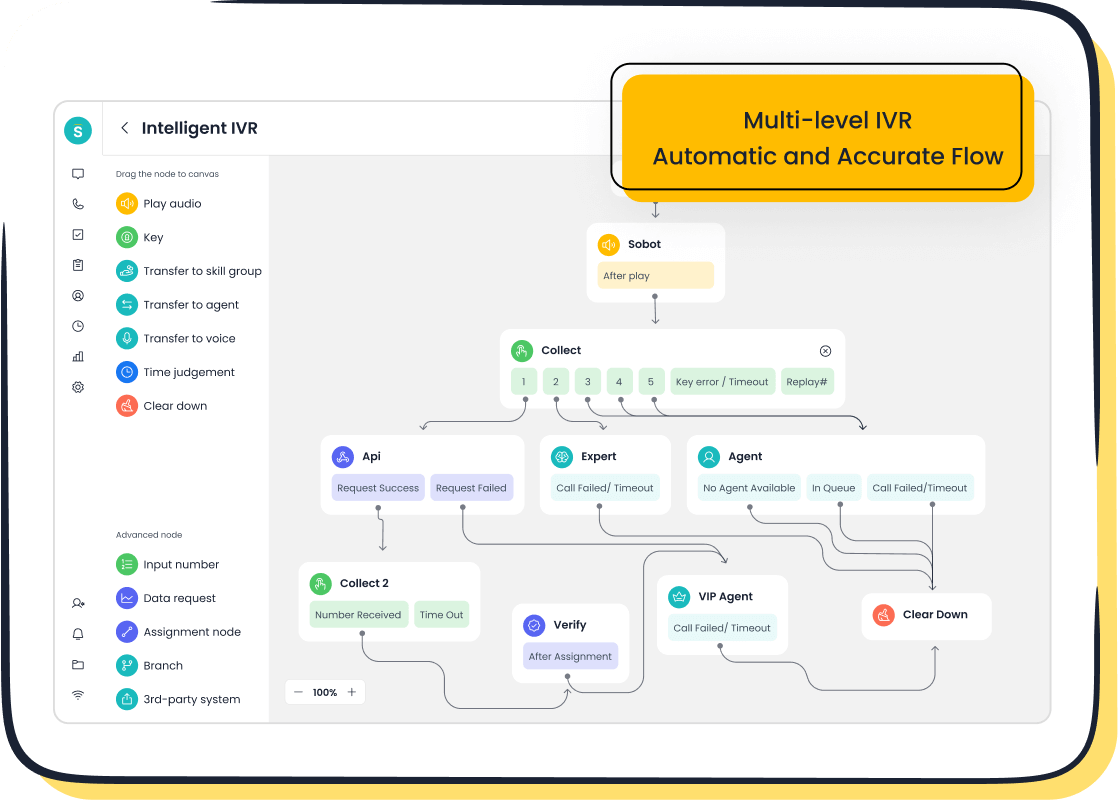How Average Call Abandonment Rate Affects Customer Satisfaction


When customers abandon calls, they leave with frustration, which directly impacts your business. Each abandoned call costs businesses around $50, potentially leading to daily losses of $4,000 in sales. Customers expect timely assistance, with 91% unwilling to return after a negative experience. Monitoring the average call abandonment rate (ACR) helps you understand operational efficiency and customer satisfaction. Meeting ACR standards improves customer loyalty and enhances your brand reputation. Solutions like Sobot’s Voice/Call Center optimize call routing and reduce wait times, ensuring a better customer experience and boosting retention.
Understanding Average Call Abandonment Rate (ACR)
What Is Average Call Abandonment Rate?
Definition and significance of ACR in customer service
The average call abandonment rate (ACR) measures the percentage of calls that customers disconnect before speaking to an agent. This metric reflects how well your customer service center meets customer expectations. A high ACR often signals inefficiencies like long wait times or poor call routing, which can harm customer satisfaction. Monitoring ACR helps you identify operational gaps and improve customer service quality. Businesses that prioritize reducing ACR often see better customer retention and loyalty.
Why ACR is a critical metric for call centers
ACR is a vital performance indicator for call centers. It directly impacts customer satisfaction and operational efficiency. For example, industries like healthcare and BFSI aim for abandonment rates below 3%, while retail accepts rates around 5%. High-performing call centers achieve rates as low as 2% to 3%. These benchmarks highlight the importance of managing ACR to maintain competitive service standards and reduce customer churn.
How to Calculate Average Call Abandonment Rate
Formula for calculating ACR
You can calculate ACR using this formula:
[Number of Calls Abandoned / Total Number of Calls] × 100 = Abandonment Rate (%)
For instance, if your center receives 1,000 calls, 50 are abandoned, and 900 are handled, the calculation would be:
(50 / 1,000) × 100 = 5%
This simple calculation helps you track and manage your call abandonment rate effectively.
Industry benchmarks and standards for ACR
Different industries have varying standards for acceptable ACR. Here’s a quick overview:
| Industry Sector | Acceptable Abandonment Rate |
|---|---|
| Healthcare | Below 3% |
| Retail | Around 5% |
| BFSI | Under 3% |
On average, call centers aim for rates between 5% and 8%. However, achieving rates below 5% can significantly enhance customer satisfaction and operational performance.
The Role of ACR in Customer Satisfaction
How ACR reflects the quality of customer interactions
A low ACR indicates that your customer service center efficiently handles calls, ensuring customers receive timely assistance. Conversely, a high ACR often results from issues like understaffing or inefficient call routing. These problems can frustrate customers and damage your brand reputation. Reducing ACR improves customer service quality and enhances the overall customer experience.
Connection between ACR and customer loyalty
Customers value quick and effective service. High abandonment rates can push them toward competitors, while lower rates foster trust and loyalty. Research shows that reducing queue times to under two minutes can decrease abandonment rates and boost daily revenue by $3,000. By addressing ACR, you not only improve customer satisfaction but also strengthen long-term loyalty.
Common Causes of High Call Abandonment Rate
Long Wait Times
Impact of excessive hold times on customer patience

Long wait times are one of the most common reasons for high call abandonment rates. Studies show that most customers are unwilling to wait more than five minutes for assistance. Extended hold times often lead to frustration, causing customers to hang up before their issues are resolved. This not only impacts customer satisfaction but also damages your brand's reputation. For example, states like Florida and New Mexico reported wait times exceeding 30 minutes, which significantly increased call abandonment rates. To reduce wait times, you can implement advanced solutions like Sobot’s Voice/Call Center, which uses AI-powered IVR systems to streamline call handling and improve efficiency.
Examples of industries with high wait time challenges
Industries like healthcare and financial services often face challenges with long wait times due to high call volumes and complex inquiries. Retail businesses also experience spikes during peak shopping seasons, leading to delays. For instance, during April, states such as Arizona and Utah saw increased wait times, correlating with higher abandonment rates. Addressing these challenges requires efficient call routing and adequate staffing to maintain optimal call center performance.
Inefficient Call Routing
Challenges in directing calls to the right agents

Inefficient call routing occurs when calls are not directed to the appropriate agents, leading to delays and customer dissatisfaction. Poorly designed strategies or outdated systems often result in customers being transferred multiple times or placed on hold unnecessarily. This increases frustration and contributes to high abandonment rates. For example, if a call center receives 1,000 calls and 50 are abandoned due to routing issues, the abandonment rate would rise to 5.2%. Implementing smart call routing, like the one offered by Sobot’s Voice/Call Center, ensures calls are directed to the right agents, reducing wait times and improving customer satisfaction.
How poor routing increases abandonment rates
Poor routing not only delays issue resolution but also creates a negative perception of your brand. Customers expect quick and accurate assistance. When they experience repeated transfers or long holds, they are more likely to abandon the call and seek alternatives. This directly impacts customer loyalty and operational efficiency. Leveraging data analytics and AI-driven solutions can help optimize routing and reduce abandonment rates.
Insufficient Staffing in Call Centers
Effects of understaffing on call center performance
A lack of agent availability often results from insufficient staffing, which directly impacts call center performance. When there aren’t enough agents to handle incoming calls, wait times increase, leading to higher abandonment rates. This is particularly evident during unexpected surges in call volume. For example, insufficient staffing during peak hours can cause delays, frustrating customers and reducing satisfaction. Sobot’s workforce management tools can help you optimize staffing levels to meet demand effectively.
Seasonal demand spikes and their impact on ACR
Seasonal spikes, such as holiday shopping periods, often overwhelm call centers. Without proper planning, these surges lead to longer wait times and higher abandonment rates. For instance, retail businesses frequently experience a surge in calls during Black Friday, resulting in a lack of agent availability. Preparing for these spikes with scalable solutions, like Sobot’s Cloud Call Center, ensures your team can handle increased volumes without compromising service quality.
Technical and System Issues
System outages and dropped calls
System outages and dropped calls are major contributors to high abandonment rates. When your call center experiences technical failures, customers often face abrupt disconnections. This leaves them frustrated and unwilling to call back. For instance, a study by ICMI revealed that 77% of customers feel dissatisfied when their calls drop unexpectedly. These interruptions not only harm customer satisfaction but also reduce your chances of resolving issues on the first attempt.

To minimize these disruptions, you need a reliable system with high uptime. Sobot’s Voice/Call Center ensures 99.99% system stability, reducing the risk of outages. Its global network with 110 points of presence guarantees smooth operations, even during peak hours. By investing in robust technology, you can maintain seamless communication and keep your customers engaged.
The role of outdated technology in high ACR
Outdated technology often lacks the efficiency needed to handle modern customer demands. Old systems may struggle with call routing, leading to delays and repeated transfers. This inefficiency frustrates customers and increases the likelihood of abandoned calls. For example, a report by Deloitte found that 62% of customers expect businesses to use advanced technology for faster service.
Upgrading to AI-powered solutions like Sobot’s Voice/Call Center can transform your call center operations. Features such as intelligent IVR and smart call routing ensure calls reach the right agents quickly. Additionally, real-time monitoring tools help you identify and resolve issues before they escalate. By modernizing your technology, you can significantly lower abandonment rates and improve customer satisfaction.
Tip: Regularly audit your call center systems to identify outdated components. Upgrading these systems can save you from losing valuable customers.
The Impact of Call Abandonment Rate on Customer Satisfaction

Emotional Responses to Abandoned Calls
Frustration and dissatisfaction among customers
When customers abandon calls, they often feel undervalued and frustrated. High call center abandonment rates directly correlate with negative emotions. Studies show that customers typically hang up after waiting for an average of 2 minutes and 36 seconds. Long wait times, especially those exceeding industry benchmarks like the 80/20 service level (80% of calls answered within 20 seconds), amplify dissatisfaction. Many call centers fail to meet this standard, leaving customers feeling neglected. Shorter hold times, on the other hand, create a positive customer experience and reduce frustration. By addressing these delays, you can significantly improve customer satisfaction and lower abandonment rates.
How abandoned calls erode trust in a brand
Abandoned calls damage trust. Customers expect prompt and efficient service. When they experience high abandonment rates, they perceive your business as unreliable. This perception can lead to a loss of confidence in your brand. For example, if your call center abandonment rate exceeds the average of 6%, customers may hesitate to engage with your services again. Reducing abandonment rates through solutions like Sobot’s Voice/Call Center, which offers intelligent IVR and smart call routing, helps rebuild trust and ensures a seamless customer experience.
Effects on Customer Loyalty and Retention
Increased likelihood of customers switching to competitors
High abandonment rates push customers toward competitors. Research reveals that 60% of customers consider switching after just one or two negative experiences. Each abandoned call represents a missed opportunity to resolve issues and retain loyalty. For instance, if your call center handles 1,000 calls daily and 50 are abandoned, you risk losing $2,500 in potential revenue. Addressing these gaps can prevent customer churn and improve retention.
Long-term damage to brand reputation
Call abandonment doesn’t just affect immediate interactions; it harms your brand’s long-term reputation. Customers share negative experiences, influencing others to avoid your services. A high call center abandonment rate signals inefficiency, which can deter potential clients. By leveraging Sobot’s advanced analytics and AI-powered tools, you can monitor and reduce abandonment rates, safeguarding your brand image and fostering loyalty.
Real-World Examples of ACR Impact
Case studies of businesses with high ACR
Businesses with high abandonment rates often face significant challenges. For example, during peak shopping seasons, retail companies experience surges in call volumes. Without proper staffing or efficient call routing, abandonment rates spike, leading to lost sales and dissatisfied customers. Sobot’s Voice/Call Center has helped businesses overcome these challenges by optimizing call handling and reducing wait times.
Lessons learned from reducing ACR
Reducing the average call abandonment rate requires strategic planning. Companies that invest in AI-driven solutions, like Sobot’s intelligent IVR, see measurable improvements. For instance, reducing queue times to under two minutes can increase daily revenue by $3,000. These lessons highlight the importance of proactive measures in enhancing customer satisfaction and operational efficiency.
The Impact of Call Center Abandonment Rate on Business Performance
Financial Implications of High ACR
Loss of revenue from abandoned sales inquiries
Every abandoned call represents a missed opportunity to convert a sales inquiry into revenue. For example, if your call center receives 1,000 calls daily and 50 are abandoned, you lose potential sales worth thousands of dollars. High call abandonment rates discourage customers from completing transactions, especially in industries like retail and financial services. By analyzing call center metrics, you can identify patterns and implement solutions like Sobot’s Voice/Call Center to reduce abandonment rates. Features like AI-powered IVR and smart call routing ensure customers stay engaged, increasing the likelihood of successful sales conversions.
Increased costs of reacquiring dissatisfied customers
When customers abandon calls, they often leave dissatisfied. Reacquiring these customers requires additional marketing and outreach efforts, which increase operational costs. Studies show that acquiring a new customer costs five times more than retaining an existing one. By improving customer experience metrics, you can reduce abandonment rates and minimize the need for costly reacquisition strategies. Sobot’s analytics tools help you monitor performance metrics and address pain points, ensuring customers remain loyal to your brand.
Operational Challenges
Strain on call center resources due to repeated calls
Abandoned calls often lead to repeated attempts by customers to reach your call center. This increases call volumes and strains resources, making it harder for agents to manage incoming inquiries efficiently. For example, if 10% of calls are abandoned, your agents may face a 15% increase in workload due to repeat calls. Efficient call center metrics tracking can help you identify these trends and optimize operations. Sobot’s unified workspace streamlines call management, reducing strain and improving agent performance.
Negative impact on agent productivity
High abandonment rates affect agent morale and productivity. When agents deal with frustrated customers who have already experienced poor service, their efficiency decreases. This creates a cycle of dissatisfaction that impacts overall call center performance. By leveraging tools like Sobot’s real-time monitoring and smart call routing, you can reduce abandonment rates and empower agents to deliver better service.
Key Metrics Affected by ACR
Decline in Net Promoter Score (NPS)
Net Promoter Score (NPS) measures customer satisfaction and loyalty. High call abandonment rates negatively impact NPS, as dissatisfied customers are less likely to recommend your brand. For instance, a call center with an abandonment rate above 8% may see a 20% drop in NPS. Monitoring and analyzing call center metrics can help you address these issues. Sobot’s Voice/Call Center provides actionable insights to improve customer experience metrics and boost NPS.
Lower Customer Lifetime Value (CLV)
Customer Lifetime Value (CLV) reflects the total revenue a customer generates over their relationship with your business. High abandonment rates reduce CLV by driving customers to competitors. For example, a retail business with a 5% abandonment rate may lose $10,000 in potential lifetime revenue annually. By improving call center metrics, you can enhance customer satisfaction and increase CLV. Sobot’s AI-powered solutions ensure seamless communication, helping you retain customers and maximize their lifetime value.
Strategies to Reduce Average Call Abandonment Rate

Optimize Staffing and Scheduling
Use of workforce management tools
Effective staffing ensures your call center can handle customer inquiries without delays. Workforce management tools help you predict call volumes and schedule agents accordingly. These tools analyze historical data to forecast peak hours, enabling you to allocate resources efficiently. For example, using Sobot’s workforce management solutions, you can optimize agent availability and reduce wait times. This approach minimizes the risk of abandoned calls and improves the overall customer experience.
Strategies for handling peak call volumes
Handling peak call volumes requires preparation. Seasonal spikes, such as holiday shopping periods, often overwhelm call centers. You can address this by hiring temporary staff or cross-training existing employees to manage increased demand. Additionally, implementing callback options during high-traffic periods allows customers to avoid long waits. Sobot’s Voice/Call Center offers features like bulk outbound tasks and real-time monitoring, helping you manage surges effectively while maintaining service quality.
Leverage Technology with Sobot Voice/Call Center

Implementing AI-powered IVR systems
AI-powered IVR systems streamline call handling by automating routine tasks. These systems greet customers, identify their needs, and route calls to the appropriate agents. This reduces wait times and enhances efficiency. For instance, Sobot’s intelligent IVR allows you to customize menus and workflows, ensuring a seamless interaction. Businesses using AI-driven IVR systems report up to a 30% reduction in call abandonment rates, making it one of the most proven strategies to reduce call abandonment rates.
Using Sobot's Voice/Call Center for smart call routing
Smart call routing ensures customers connect with the right agents quickly. Sobot’s Voice/Call Center uses AI to analyze customer data and match inquiries with the most suitable agents. This reduces unnecessary transfers and improves first-contact resolution rates. By leveraging this technology, you can enhance customer satisfaction while optimizing call center performance.
Improve Call Routing Efficiency
Ensuring calls are directed to the right agents
Directing calls to the right agents improves resolution times and reduces frustration. Poor routing often leads to repeated transfers, increasing abandonment rates. Sobot’s smart call routing uses rule-based workflows to ensure calls reach the appropriate team. This approach not only lowers abandonment rates but also boosts customer trust in your service.
Using data analytics to enhance routing
Data analytics plays a crucial role in optimizing call routing. By analyzing call patterns and customer behavior, you can identify bottlenecks and improve efficiency. Sobot’s analytics tools provide real-time insights, helping you make data-driven decisions. These tools are part of effective strategies to lower call abandonment and improve the customer experience.
Enhance Customer Communication
Providing estimated wait times to customers
Proactively informing customers about their wait times can significantly improve their experience. When you provide estimated wait times, you set clear expectations, which helps reduce frustration. For instance, studies show that proactive communication, such as displaying wait times, minimizes call abandonment rates. Customers feel more in control when they know how long they need to wait. This simple step can transform a potentially negative experience into a manageable one.
Sobot’s Voice/Call Center offers intelligent IVR systems that can automatically calculate and share estimated wait times with callers. This feature not only enhances transparency but also builds trust in your service. Businesses that adopt such solutions often see a noticeable drop in their call abandonment rate, leading to higher customer satisfaction.
Offering callback options to reduce frustration
Callback options provide an effective way to address long wait times. Instead of forcing customers to stay on hold, you can offer them the choice to receive a callback when an agent becomes available. This approach reduces frustration and ensures customers feel valued. Automating sections of the call process, like callbacks, has proven to lower abandonment rates and improve overall service efficiency.
With Sobot’s Voice/Call Center, you can implement seamless callback options. The system allows customers to schedule callbacks at their convenience, ensuring they don’t have to wait unnecessarily. This feature not only improves the customer experience but also optimizes your call center’s workflow.
Monitor and Analyze Call Abandonment Rate
Regularly reviewing ACR metrics with Sobot's analytics tools
Tracking your call abandonment rate regularly is essential for identifying areas of improvement. By analyzing ACR metrics, you can pinpoint patterns, such as peak call times or recurring issues, that contribute to high abandonment rates. Sobot’s analytics tools provide real-time insights into these metrics, enabling you to make data-driven decisions. For example, if your ACR spikes during specific hours, you can adjust staffing levels or implement additional support measures.
Using customer feedback to identify pain points
Customer feedback is a valuable resource for understanding why calls are abandoned. When you actively seek feedback, you gain insights into the challenges your customers face, such as long wait times or poor call routing. This information helps you address pain points effectively. Sobot’s unified workspace integrates customer feedback seamlessly, allowing you to analyze and act on it. By combining feedback with ACR metrics, you can create a more customer-centric approach to service.
Understanding and addressing Average Call Abandonment Rate (ACR) is vital for improving customer satisfaction and business performance. Tracking metrics like customer satisfaction helps refine services and create exceptional interactions. Businesses often struggle to balance personalization with efficiency, especially when managing feedback across channels. By reducing ACR, you can enhance trust, loyalty, and operational efficiency. Solutions like Sobot’s Voice/Call Center offer smart call routing and AI-powered IVR to streamline processes and reduce wait times. These tools ensure seamless communication, helping you deliver better experiences and achieve long-term success. Explore Sobot’s solutions here.
FAQ
What is the ideal call abandonment rate for a contact center?
The ideal call abandonment rate varies by industry. For most contact centers, a rate below 5% is considered excellent. Industries like healthcare and financial services aim for rates under 3%. Achieving this benchmark ensures better customer satisfaction and operational efficiency.
How can technology help reduce call abandonment rates?
Advanced tools like AI-powered IVR systems and smart call routing streamline operations. For example, Sobot’s Voice/Call Center uses intelligent workflows to direct calls efficiently. These features reduce wait times and improve the overall experience, helping your contact center lower abandonment rates.
Why do customers abandon calls in a contact center?
Customers abandon calls due to long wait times, poor call routing, or technical issues. For instance, outdated systems may delay responses, frustrating callers. Addressing these challenges with solutions like Sobot’s Voice/Call Center ensures smoother interactions and fewer abandoned calls.
How does staffing affect call abandonment rates?
Insufficient staffing leads to longer wait times, increasing call abandonment rates. Proper workforce management tools, like those integrated into Sobot’s contact center solutions, help optimize agent availability. This ensures your team can handle peak volumes effectively.
What metrics should a contact center monitor to reduce abandonment rates?
Key metrics include average call abandonment rate, average wait time, and first-contact resolution rate. Sobot’s analytics tools provide real-time insights into these metrics, helping you identify and address problem areas in your contact center.
See Also
Essential Software for Ensuring Call Center Quality Assurance
Top Strategies for Effective Call Center Quality Management
Understanding the Efficiency of Call Center Automation
Enhancing Call Center Performance Through Effective Monitoring